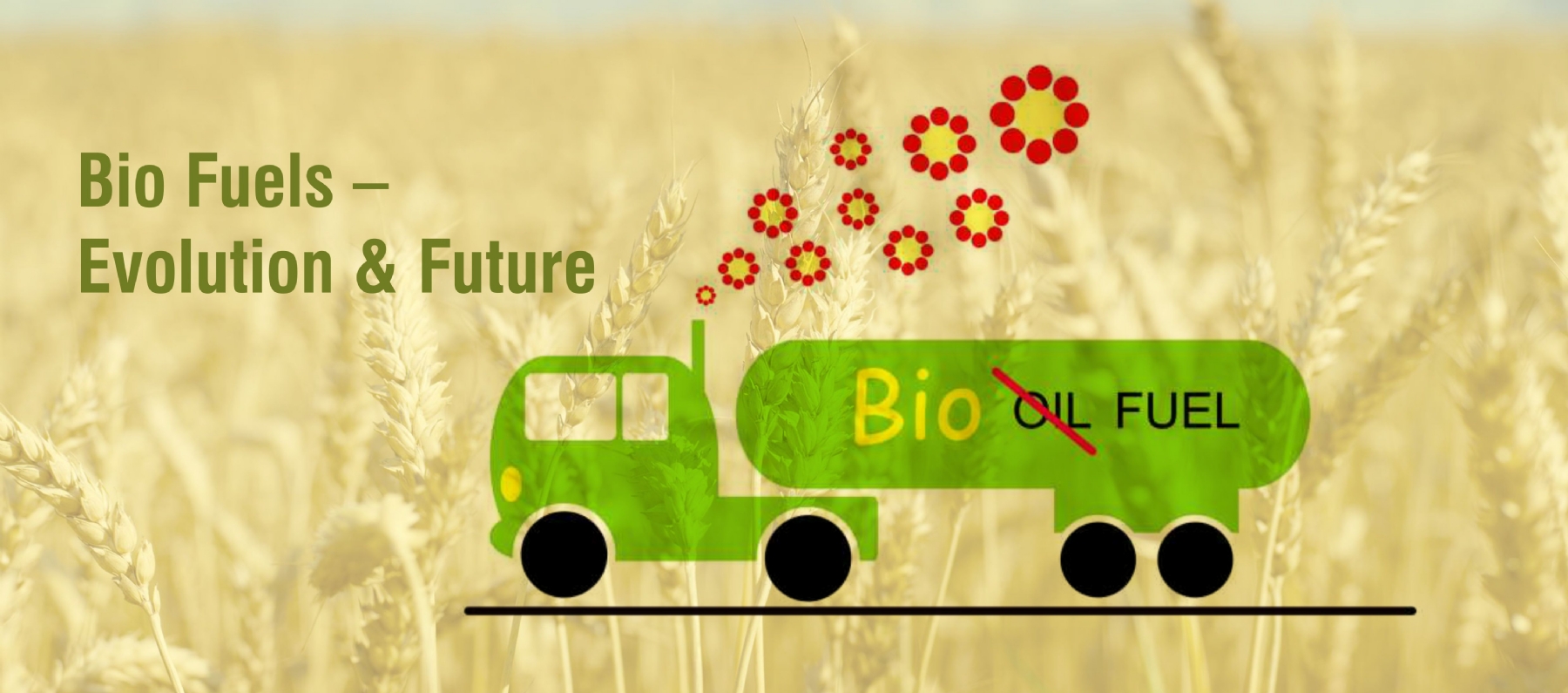Bio Fuels – Evolution & Future

Bio Fuels – Evolution & Future
Need For Alternate Fuel:
Fuels are any materials that store potential energy in forms that can be practicably released and used for work or as heat energy. The concept originally applied solely to those materials storing energy in the form of chemical energy that could be released through combustion, but the concept has since been also applied to other sources of heat energy such as nuclear energy as well.
Fuels are required for a variety of purposes from dawn to dusk but used chiefly for power generation and transportation. The generation of electricity is the single largest use of fuel in the world and more than 60 % of power generated comes from fossil fuels. Globally, transportation accounts for 25% of energy demand and nearly 62% of oil consumed. At this rate, if it continues as it is we shall soon exhaust the resources of fossil fuels and hence alternate fuel resources is the need of the hour.
What Is Bio Fuel? :
While fossil fuels are generated out of remains of a dead animal or flora fauna of the past, bio-fuel is a hydrocarbon that is made from a living organism that can be used to power something. In practical consideration, any hydrocarbon fuel that is produced from organic matter (living or once living material) in a short period of time (days, weeks, or even months) is considered a bio-fuel.
Bio-fuels have been around for a long time now but little focus was given onto them until recent times. In fact, Henry Ford originally designed the Model T to run on ethanol, and people have been running diesel engines on vegetable oil much longer than they have been running diesel engines on petroleum-based diesel fuel. Even the inventor of the diesel engine Rudolf Diesel originally designed it to run on vegetable oil. The reason petroleum based fuel originally won out over bio-fuel because of cost. But now that fossil fuels are becoming more expensive with the run, exhaustion and less abundance, the demand for bio-fuel is at increase. Bio-fuel surged in popularity during the energy crisis of the 1970s. The most recent surge in bio-fuel popularity occurred in the 1990s in response to tougher emissions standards and increasing demands for enhanced fuel economy.
Production of Bio Fuel and Their Energy Content:
Sugar crops and starch are grown & through the process of fermentation ethanol is produced. Plants are grown naturally to produce oil like algae and oils are heated to reduce their viscosity then use directly as diesel for fuel engines.
The energy content of biodiesel is about 90% that of petroleum diesel. The energy content of ethanol is about 50% that of gasoline. The energy content of butanol is about 80% that of gasoline. Most bio-fuels are at least as energy dense as coal, but produce less carbon dioxide when burned.
First Generation Bio Fuels:
First generation bio-fuels are produced directly from food crops. The bio-fuel is ultimately derived from the starch, sugar, animal fats, and vegetable oil that these crops provide. It is important to note that the structure of the bio-fuel itself does not change between generations, but rather the source from which the fuel is derived changes. The sources of First- Generation Bio-fuels are corn, sugar cane, soybeans, vegetable oil and other candidate crops.
Second Generation Bio Fuels:
Second generation bio-fuels are also known as advanced bio-fuels. What separates them from first generation bio-fuel is the fact that feedstock used in producing second generation bio-fuels are generally not food crops. The only time the food crops can act as second generation bio-fuels is if they have already fulfilled their food purpose. For instance, waste vegetable oil is a second generation bio-fuels because it has already been used and is no longer fit for human consumption. Because second generation bio-fuels are derived from different feed stock, Different technology is often used to extract energy from them. This does not mean that second generation bio-fuels cannot be burned directly as the biomass. In fact, several second generation bio-fuels, like switch grass, are cultivated specifically to act as direct biomass.
Third Generation Bio Fuels:
The term third generation bio-fuel has only recently entered the mainstream. It refers to bio-fuel derived from algae. Previously, algae were lumped in with second generation bio-fuels. However, when it became apparent that algae are capable of much higher yields with lower resource inputs than other feedstock, many suggested that they be moved to their own category.
Environmental Factors with Bio Fuels:
Bio-fuels burn cleaner than fossil fuels, resulting in fewer tailpipe emissions of greenhouse gases, particulate emissions, and substances. However, Bio-fuel production uses anywhere from 2 to 84 times as much water as fossil fuel production. But, Water use can be mitigated by planting crops that do not require irrigation. Bio-diesel is sulfur free, but contains nitrates that contribute to acid rain. Bio Diesel has fewer polyclinic aromatic hydrocarbons (studies show that these hydrocarbons are linked to cancer). Bio-fuels are degradable, so if they do spill, less harm is done compared to when fossil fuels spill.

